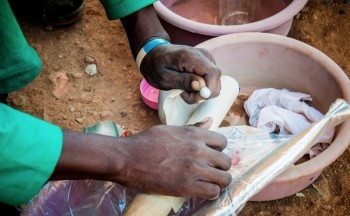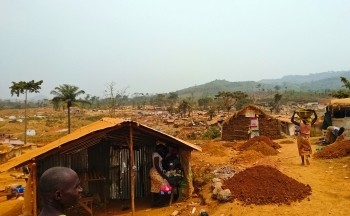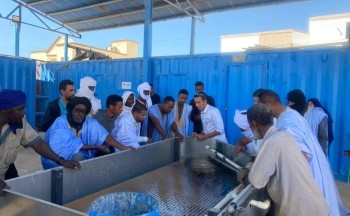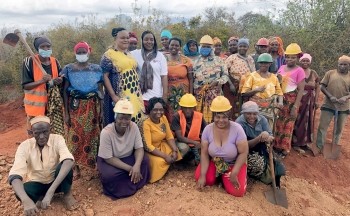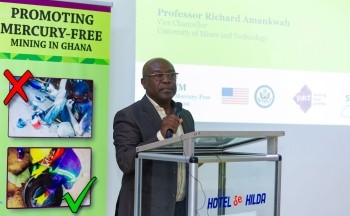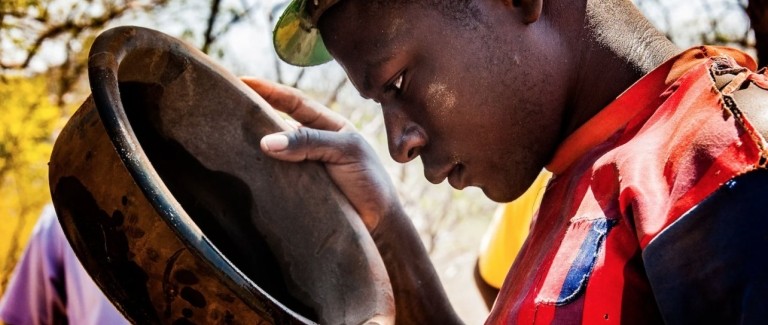
Gold Mining
Pact works in partnership with gold mining communities to end dangerous practices and create positive, sustainable social and economic impact.
Artisanal and small-scale gold mining, or ASGM, produces about 15 percent of the world's newly mined gold. At least 16 million people make a living through ASGM, including more than 4.5 million women. Another 80 million people indirectly depend on ASGM, in view of the sector’s positive economic spillover effects in rural, impoverished communities.
Besides this socio-economic importance, the sector is an important pillar of stability in fragile and conflict-affected settings where it tends to thrive. For example, ASGM offers marginalized youth with an alternative to joining criminal or extremist groups and provides local governments with critical revenue for development.
An inclusive formalization of this largely informal sector can unlock the sector’s full peacebuilding and sustainable development potential, with positive impacts on each of the 17 Sustainable Development Goals.
However, as a consequence of its informal nature and limited access to support services, gold mining is associated with a number of environmental and health impacts. For example, many gold miners use hazardous chemicals such as mercury and cyanide as part of the mining process.
In some 70 countries worldwide, artisanal gold miners add mercury to crushed rocks or sediment containing gold. The mercury binds with gold particles like a glue, creating a mixture called amalgam. The amalgam is then heated to evaporate the mercury, leaving the gold behind. Inhaling mercury fumes poses the greatest danger to miners and their families. Extreme contamination can lead to organ failure and death, and pregnant women can pass exposure to their babies, causing neurological and developmental abnormalities.
By endorsing the Minamata Convention on Mercury, the global community has agreed to take action to reduce and eventually end mercury use in ASGM. But making this happen isn’t simple. No single, non-toxic alternative currently exists to replace mercury, and mercury bans risk depriving rural communities of this critical livelihood.
Cyanide is the current large-scale mining industry standard for gold extraction from milled ore. While cyanide can be used safely with rigorous safeguards, in practice the process presents considerable risks to workers, communities and the environment.
What we do
Pact is taking a holistic approach to support gold miners and traders in professionalizing their livelihoods to reduce ASGM’s dangers and ensure positive social, economic and environmental impacts in rural communities. Working with communities, governments and private partners, Pact leverages market forces for the sustainable transformation of gold mining in Sub-Saharan Africa, Latin America and Asia.
In Zimbabwe, where Pact found widespread use of mercury in ASGM, Pact supported the government in developing a National Action Plan for mercury reduction. Pact also piloted low-cost fumehoods and retorts to reduce mercury use and exposure, and delivering education and practical training to gold miners and refiners.
In Nigeria, with support from the government of Australia, Pact worked with local fabricators and miners to test low-cost, improved sluicing to better capture fine gold. And in Kenya, Pact has strengthened ASGM cooperatives and associations on formalization, business management and supply chain due diligence.
To address the use of cyanide in ASGM, in partnership with planetGOLD, Pact has produced guidance on cyanide management written specifically for the artisanal gold mining sector worldwide. The guide aims to ensure that the risks of cyanide are well understood and that regulators and users have accurate information and training to ensure their compliance with regulations formulated to mitigate the health, safety, social and environmental risks.
Our newest ASGM efforts are in West Africa, where Pact and our partners are demonstrating the business case for responsible artisanal gold mining. In Mauritania, the sector is currently nascent, informal, reliant on mercury and vulnerable to intrusion from insurgent groups operating in the wider Sahel region. With partners Magma Group and Aurum Monaco, and funds from the European Partnership on Responsible Minerals, Pact is supporting ASGM miners to formalize and adopt improved methods for gold processing with reduced environmental and health impacts. By establishing an exporting company under Magma, the partners aim to build a transparent supply chain from Mauritania’s gold mines to the European market.
In Ghana and Mali, with funding from the U.S. State Department, we are reducing mercury use through education, the introduction of better technology, strengthened supply chains and business incentives for mercury-free gold production.
In Sierra Leone, the government has developed a National Action Plan to reduce mercury use in the ASGM sector, through formalization, introduction of better mining practices and advancing gender equality in ASGM communities. In partnership with GIZ, Pact is helping stakeholders to kick-start implementation of the NAP by supporting responsible gold production and trade and improved, formal market access for ASGM miners and gold traders.
Gold Mining PROJECTS
Gold Mining Resources
-
Mercury-free techniques for the processing of gold ores in the artisanal and small-scale gold mining sector in Mauritania
-
Piloting NAP Implementation in Sierra Leone
-
Responsible gold mining at Pact
-
Fact sheet: Promoting Mercury-Free Mali
-
Responsible gold trading: Analysis of the main obstacles to and key recommendations for formal gold trade in Mali
Stay Updated. Subscribe Now.
Pact's e-newsletter offers the latest on our efforts around the world to build thriving, resilient and engaged communities that are leading their own development.
